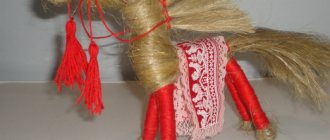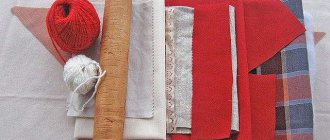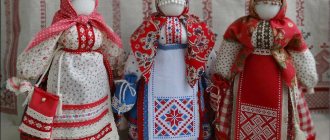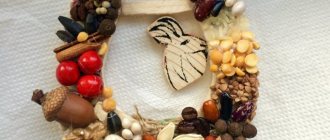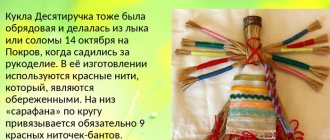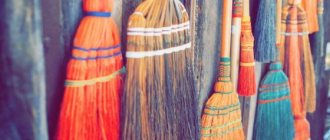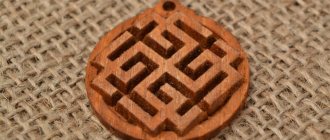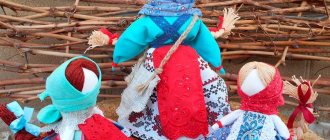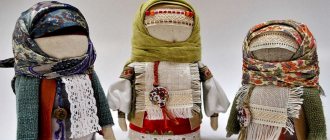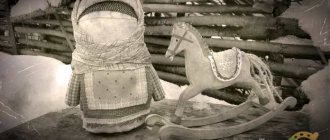Since ancient times, the motanka rag doll was used by the Slavs as a talisman or ritual object. Such talismans were a person’s companions throughout his life’s journey from birth to death. Handmade rag beauties were present in every home. Our ancestors believed in the magical power of this talisman. They were made exclusively by women. During the process of creating the amulet, the man had no right to observe or even be nearby. The dolls were made faceless and made exclusively from natural materials. They were not just toys, but protected a person, home and family, and served as a sacred object at childbirth, weddings, and holidays. The rag doll, whose history goes back centuries, is gaining new life - becoming popular in the modern world.
Doll Zernovushka
Doll Zernovushka - a talisman for wealth and abundance
The personification of wealth in the Slavic family was the doll Zernovushka, which was also called Pea, Krupenichka. People believed that it attracted wealth to the house and contributed to a good harvest. Depending on the area, it could look different, but it was always based on a bag filled with grain. Most often, buckwheat, wheat, peas, barley, and oats were poured. The doll was placed in the most visible place in the house. The wealth of the family could be determined by the appearance of the talisman. If the doll is fat, it means that abundant crops have been harvested, which promises a well-fed winter. Sometimes such amulets were made in the guise of a man and were called Rich Men. In addition, Krupenichki was a ritual item during spring sowing. The first to throw grain into the ground was from the doll's bag. In the fall, they filled it with selected seeds of the new harvest, in the hope that the next one would be the same. Krupenichka is one of the most revered rag amulets; it was believed that it preserves the power of Mother Earth, which gives hope for a favorable spring, a summer with warm rains, and an abundant autumn. It is customary to give grain of grain on the holiday of Kolyada, when they gave thanks to the gods for a rich harvest. These days, a doll can be given as a gift for housewarmings and weddings.
Meaning
Despite the simple method of production, Krupenichka has important meaning for the home. Previously, the doll protected from crop failure and hunger, from a hungry winter, and gave hope for fertile soil and warm summers. It was presented as a gift on Kolyada. The pupa contributed to a good harvest for subsequent years.
For the Slavic people, the amulet doll Krupenichka and the rich man meant not only wealth in the house, but also the wealth of fruits on the lands. Then grains from the first harvest were placed in it.
The Slavs made dolls for several reasons:
- To increase the grain harvest;
- To preserve grain from rodents;
- To save the house from evil spirits;
- For storing grain from rotting;
- For a safe birth.
The grains were not subjected to special grinding, were not dried or fried. It was important to preserve fresh grains until the next sowing; the grains from the pupae were taken first.
In modern times, Krupenichka is given to new residents for prosperity in their new home. The doll is also given as a gift for weddings to protect the newlyweds’ wealth.
Making Krupenichka
It’s not difficult to make a similar Zernovushka doll with your own hands. The main thing is to know the features and follow the rules when making a talisman:
- The doll must be faceless;
- Only natural materials are used in the work;
- Do not use sharp objects (needle, scissors)
- Clothes are not sewn, but wrapped.
- When making, thoughts should be bright.
- If you are sick or worried about something, you should not do work.
- According to Slavic traditions, handicrafts are not done on Friday and Sunday until lunch.
- Charms for profit are made on the waxing moon.
- You can do it in one sitting, without stretching it out over several days.
We will show you how to make a Zernovushka doll with your own hands step by step in the master class.
In our work we will use:
- A piece of canvas, calico or two-thread 20x20 cm - for the body, two pieces for the arms 17x10 cm;
- Bright colored fabric (preferably with a folklore motif) 17x7 cm, for a sundress;
- Sewing or lace 23x7 cm for the undershirt;
- Material for apron 5.5x5 cm;
- A piece of colored or plain fabric for a warmer, 23x6 cm;
- Braid for a warrior (head volume plus an allowance of 2-3 cm)
- Red natural thread (cotton, wool)
- Fabric for scarf, measure according to the head.
It will be ideal if you can tear off the flaps rather than cut them with scissors. When making a body, you cannot do without a needle, but this is the only point; we will not use it anymore. Let's start creating a doll step by step, not forgetting the rules.
- We take a piece of fabric for the body, bend it along the lobar and sew it along the length, in the form of a pipe.
- We tie one end tightly with thread.
- Turn it right side out. We straighten the knot, we get a bag.
- We put a coin on the bottom and fill in the cereal, leaving it about 3 cm short of the edge.
- Let's tie the bag seven turns. Some master classes recommend assembling the top with a needle and thread. It is highly undesirable to do this. In rag amulets, piercing objects are not allowed.
- We begin to dress up the doll. Having determined the border of the neck, take the fabric or lace for the skirt and wrap it around it.
- In the same way, we put on a sundress on top, which should not close in front.
- We also attach the apron by placing the flap on the face, and then straighten it down.
- We form arms, bend the fabric in half along the short side and roll it with a roller from both ends at the same time. We tie it with a rope to prevent it from unwinding.
- We take the material for the shower warmer, place the hand blanks along the edges and wind the fabric onto them, completing 5-6 turns. The center remains vacant. The rollers with their bent end “peek out” from the fabric by 0.5 cm - these are the palms of the doll.
- We place the doll in the center of the soul warmer, the twists should be on the sides. We fasten the structure to the body with thread.
- We take the braid, wrap it around the head, cross it at the back and wrap it along the neck line. Thus the warrior turned out.
- We put a scarf on top, having first straightened the knot on the top of the head.
- The doll that will attract wealth to your home is ready.
The apron can be complemented with lace, braid or sacred embroidery. In this case, you will have to use a needle, which is not advisable. If you still decide to decorate your apron. Sew it away from the pupa.
Modern needlewomen sometimes make Krupenichka from a sock; it is the base and is filled with cereal. All other execution stages are the same. The advantage of this method is that there is no need to use a needle.
"Krupenichka and Bogach"
The Tale of Krupenichka
Voivode Vseslav had an only daughter named Krupenichka. Year after year passed, and from a fair-haired girl with blue eyes, Krupenichka turned into a rare beauty. Her parents began to think about who to marry her to. They didn’t even want to think about giving their daughter away to someone else and chose a son-in-law so that they could all live together and never be separated from Krupenichka. The fame of the wondrous beauty spread far and wide, and Vseslav was very proud of this. But old mother Varvarushka was afraid of such fame and always got angry when she was asked about Krupenichka’s beauty. “We don’t have any beauty!” she grumbled. “The neighbors over there have truly beautiful daughters.” And our maiden is like a maiden: there are many like ours everywhere. And she herself couldn’t stop looking at her Krupenichka. She knew that there was no one more beautiful than her; and there is nothing more beautiful, and kinder, and sweeter. Old and young, poor and rich, friends and strangers - everyone loved Krupenichka for her kind heart. The people even have a song about her: Krupenichka, red maiden, You are our dove, joy is the heart, Live, bloom, grow young, Be a joy to all good people! The fame of Krupenichka’s beauty flew and flew and reached the Basurman camp, the military leader Talantai. -Hey you, brave warriors, daring riders! Show me what kind of beauty Voivode Vseslav’s daughter, Krupenichka, is!” said Talantay. “Isn’t she fit to be our khan’s wife?” Three riders mounted their horses and put on their robes: one put on a robe green, like grass; the other is gray, like a forest road, the third is brown, like a pine trunk. The riders narrowed their sly eyes, smiled at each other with only the corners of their lips, fervently shook their shaved heads in shaggy hats and rode off, galloping with youthful shouts. And a few days later they returned and brought with them Talantay, a gift for her khan; wonderful beauty Krupenichka. She went with her mother Varvarushka to swim in the lake, and in the forest, as if on purpose, berry after berry, ripe strawberries lured deeper into the thicket. And her mother tells her everything about the grass that grows like white stars in the middle of the lake; you need to collect this overpowering grass and sew it into your belt, and then no harm will happen to the person; the overcoming grass will avert all misfortune. And before both of them had time to scream, suddenly a column of gray dust rose from the path in front of them, on one side a forest pine stump fell from its place and threw itself at their feet, and on the other side a green bush jumped at them. They picked up Krupenichka, and only then did Mother Varvarushka see what kind of green bush it was. She clung to him with all her strength, but the infidel slyly twisted and slipped out of his clothes. Varvarushka fell to the ground with a green robe in her hands. And what happened next, she did not know, did not know, as if her mind had been darkened by grief. She sits all day on the shore of the lake, looks at the expanse of water and keeps saying: “Odolen-grass!” Conquer me high mountains, low valleys, blue lakes, steep banks, dense forests, let me, overcome the grass, see my dear Krupenichka! She was sitting over the lake, grieving and crying, when suddenly a passing old man came up to her - short, skinny, with a white beard, with a handbag over his shoulders - and said to Varvarushka: “I’m going to the far side of the Basurman.” Shouldn’t I take a bow from you to someone? Varvarushka looked at him and asked: “Who are you, good man?” What is your name? - And my name is Odolen-grass. Varvarushka was delighted, threw herself crying at the old man’s feet and again began to scream like crazy: “Odolen-grass!” If you had overcome evil people, they wouldn’t think badly of us, they wouldn’t do anything bad to us. Give me back my Krupenichka, old man! The old man listened to her and affectionately answered: “If so, then be my faithful companion on the road, and my assistant in my work!” So he said to mummy and waved his sleeve over her head. And that hour Varvarushka turned into a traveling staff. The old man went with him on the journey. Where the mountain is steep, the path serves as a support for him, where the thicket is thick, he pushes the bushes apart, where the dogs are angry, he drives them away. The old man walked and walked and came to the Basurman camp where Talantay lived and where at that time a caravan was being equipped to send precious gifts to the khan. They sent gold and furs. The stones are semi-precious and were used to equip beautiful slave girls for long journeys. Among them was Krupenichka. An old man stopped at the road along which the caravan was supposed to go, unwrapped his bundle and began laying out various sweets as if for sale - here he had honey, gingerbread, and nuts. He looked around to see if there was anyone, raised his traveling staff above his head and threw it on the ground; then he waved his sleeve over him - and instead of a staff, Mother Varvarushka rose from the grass and stood in front of him. “Well, now, mommy, don’t yawn!” the old man tells her, “Look with all your eyes at the road: a small grain will soon fall on it.” When it falls, pick it up quickly, hold it in your hand and take care of it until we return home. Be careful not to lose the grain, since your Krupenichka is dear to you. So the caravan set off from the camp; He passes an old man along the road, and he sits on the lawn, spread sweets around him and shouts friendly. -Eat, beauties, honeycombs, fragrant gingerbreads, roasted nuts! And Mama Varvarushka agrees with him: “Eat, beauties: you will be more cheerful, you will become more rosy!” When the infidels saw it, they immediately ordered to treat the beauties with sweets. And the old men brought them their treat: -Eat, eat to your health! The girls surrounded them; some chuckle, others look silently, others are sad and turn away. -Eat, girls! Eat up, beauties! From a distance Krupenichka saw her mother Varvarushka. Her heart began to leap out of her chest, and her face turned white. She feels that it is not without reason that the old woman came here and it is not without reason that she does not recognize her, but comes to her as if she were a stranger; He doesn’t say hello, doesn’t bow, walks straight at her, looks wide-eyed and only repeats the same thing in a loud voice: “Eat, dears, eat!” The old man also shouted, and in all directions he handed out nuts to some, honey to some, gingerbread to others... And everyone suddenly felt cheerful. The old man came closer to Krupenichka and threw a whole handful of gifts into the air to the left side of her over everyone’s heads, and even a handful... The girls rushed to catch and pick up the gifts, and he waved his sleeve over Krupenichka to the right - and Krupenichka was gone. Only a small buckwheat grain fell on the road instead. Mother Varvarushka rushed after him, grabbed the grain in her hand and squeezed it tightly, and the old man waved his sleeve over her - instead of Varvarushka, he picked up a traveling staff from the ground. -Eat, beauties, eat to your health!.. He quickly distributed all the leftovers, shook the empty bag, bowed goodbye to everyone and slowly went his way, leaning on his staff. The infidels also gave him an oxen bladder with kumis for the road. No one noticed that there were one fewer slaves. How long does it take, the old man returned safely to the same shore where he met Mother Varvarushka, where wide green leaves spread along the lake, and the grass bloomed like white stars on the water. He threw his traveling staff to the ground - and in front of him again stood the barbarian mother: his right hand was clenched in a fist and applied to his heart - you couldn’t tear it off. The old man asked her: “Tell me where you have a field here that has never been plowed, where the land has never been sown?” “But here, near the lake,” Varvarushka answers, “the clearing is never plowed, the land is never sown; it blooms with what it sows itself. Then the old man took a buckwheat grain from her hands, threw it on the unsown ground and said: “Krupenichka, red maiden, live, bloom, grow young for the joy of good people!” And you, buckwheat, fade, mature, curl - be you to please all people! He spoke and the old man disappeared, as if he had never been here. Mama Varvarushka looks, rubs her eyes, as if sleepy, and sees Krupenichka in front of her, her beloved beauty, alive and well. And where the small grain fell, a plant that had never been seen before grew green, and it spread flowery, fragrant buckwheat all over the country, about which even now, when it is sown, they sing an old song:
Krupenichka, the red maiden. You are our nurse, joy-heart. Blossom, fade, become younger, become wiser, curl more curly, be a pleaser to all good people!
During sowing, on June 13, in the old days, every wanderer used to be treated to his fill of porridge. The wanderers ate and praised and wished that the sowing would be happy, that buckwheat would be born in the fields, visibly and invisibly, because without bread and without porridge, our labors are worthless!
Nikolay Dmitrievich Teleshov Publishing house Malysh, M: 1988.
Activation and use of the amulet doll
For the doll to gain strength, charge it with your energy: take it in your palm, talk to it, tell it about the prosperity that your family wanted to find. Krupenichka should be placed in the living room or kitchen. According to the tradition of the Slavs, the doll was dismantled in the spring, the grain was thrown into the ground when sowing, the clothes were put in order, and sometimes replaced with new ones. On the harvest festival, the bag was filled with fresh seeds. As a rule, such amulets are made for a long period, sometimes passed down through generations - it is natural that they will wear out. A used talisman cannot simply be taken and thrown away. We need to say goodbye to the doll:
- If during this period you feel a feeling of pity and do not want to leave, this indicates that the amulet is still working and should be left for some period.
- If your thoughts are bright and you are grateful to the magical object, then it’s time to betray the talisman to the elements. Before doing this, the doll needs to be disassembled into shreds.
- Sharp objects should also not be used during this ritual. The threads are torn by hands. All components are put on fire; the flaps are not used for the next amulets dolls.
In such cases, a new talisman was made, and the Grain, which had lost its power, was given to the elements: water, earth, fire. In ancient times, wealth was closely associated with the grain harvest. Nowadays, the concept of prosperity is somewhat different, but we should not forget that “Bread is the head of everything!”, therefore a rag amulet in the form of a doll filled with seeds has not lost its meaning.
Zernovushka (Rich Couple)
This doll has several names: Zernushka, Zernovushka, Krupenichka, Goroshinka. And it may look a little different depending on the area where it is made. But it has a common basis - there is grain inside the doll. In the southern regions of Russia, on June 26, buckwheat was sown on Akulina Grechishnitsa. The first handfuls of buckwheat were taken from a bag sewn in the shape of a doll. After harvesting, the villages organized a porridge treat for the entire area. The porridge was cooked in cauldrons - right on the street. And after the harvest season, the bag from which the doll was made was again filled with selected grain from the new harvest and dressed up as a doll. The grain was carefully kept in a visible place in the red corner of the hut next to the icons. She is a sign of a well-fed life and prosperity in the family. Stores grain until the new harvest, protects from mice, rot, and thieves. Meanings of cereals in Zernovushka: Buckwheat - satiety and wealth, traditionally the doll was filled with this particular grain. Rice is the most expensive grain for the holiday; Barley - for satiety; Oats - for strength. You can also add all the cereals. They also sometimes place a coin at the bottom of the doll. Cost 300 rubles.
Rich man (Pair of grains)
In appearance, the rich man is a simple little bag, but in reality he is a faithful assistant. When creating the Rich Man, we thought about our Family and Ancestors with Love and Gratitude. Like any amulet, it was given a clear task, for example: profit and prosperity for the next year, protecting the well-being of the family, etc.
The Rich Man has grain in his bag, the basis of Satiety, Prosperity and Wealth. As a rule, the pupa is filled with barley or wheat. This means the circle of Life.
After making it, the rich man travels around the house and chooses a place for himself. It has been noticed that after a place is found, the rich man becomes unnoticeable, “invisible”. If there is a couple at home, Bogach and Zernovushka, then they are always placed side by side, as they walk hand in hand through Life together, protecting the Family, Home, Harvests. Cost 300 rubles.
Herbal egg capsule
The Herbalist makes sure that the disease does not enter the House. Warmth emanates from her, like from a caring Mistress. She is both the Protector from the evil spirits of illness and the Good Comforter. It is hung in the house above the baby's cradle. The doll is given to children to play with. It is also placed near the patient’s bed.
Helps well with insomnia and colds. This doll is filled with fragrant medicinal herbs. The doll must be crushed in your hands, moved, and the Herbal Spirit will spread throughout the room, which will drive away the spirits of illness. After 2 years, the grass in the pupa must be changed!
Ingredients of herbs: Mint, thyme, oregano - a soothing collection.
Thyme, linden, oregano - a healing collection .
We do fees individually for each Person. Cost 300 rubles.
Blacksmith Frol
Every girl in the village dreamed of marrying a blacksmith, or at least having a father-in-law who was a blacksmith. Then there is always Prosperity and Prosperity in the house, and the husband has constant work and orders.
Frol has a bet on his hands, so he has strong, strong hands.
The doll is double-sided: on one side is the husband, on the other is the father-in-law.
The doll carries the energy of Kindness, Light and Patronage. Cost 300 rubles.
Desire
THE WISHER is a Charm of Help; she takes trouble away from the mistress, taking pity on her. The most amazing thing is that the Desire actually fulfills the mistress’s wishes. When making wishes, they give the doll a gift in the form of a bead, button, ribbon, bell, or earring. In general, they discharge it in every possible way. Over time, the doll becomes more and more elegant. They ask her to help make their wish come true. A prerequisite is that the desire should not bring harm or misfortune to anyone, and should be sincere and from the Soul. Traditionally, the DESIRE doll is hidden in a special bag or box, placed or hung in a place inaccessible to prying eyes. Next to the doll should always be her mirror in a beautiful frame. It is better to make wishes on the waxing moon. You need to get the doll and tell it about your desire. Describe your desire in as much detail as possible, visualize it, tell it out loud, the doll must understand exactly what you want from it. When you talk about what you want, construct your phrases very carefully; negative particles in speech interfere with the fulfillment of your wish. Give your DESIRE a gift: beautiful buttons and bells on our sundress/dress, sew coins on the hem, tie a bow or ribbon. Bring her mirror to the doll and say: “Look how beautiful you are. And for a gift, fulfill my wish.” And then hide your girlfriend in a secluded place for the time being... You may not believe it, but everything you ask will come true. Sometimes it’s worth giving gifts to a DESIRE without asking, but simply because you are in a Blissful state of Spirit, and it’s better if it’s something a little different from what you usually give. For example, beads or stones are strung only on a belt around the doll and only when the doll has done something, but not before the wish is fulfilled. The DESIRE doll-amulet is kept throughout its entire life and becomes more and more elegant over time. There is no need to show it to anyone. Cost 300 rubles.
Feverish women
Rag dolls Fever is a disease bait. Their role is to attract the attention of the disease that has flown into the house: the evil spirit of the disease will fly into the house in search of its victim, see the bright, elegant Lichomaniac dolls, think that this is a person, and move into one of them...
According to ancient Slavic mythology, various diseases associated with chills or fever were called fevers or skinny evil sisters-shakers.
Sisters can walk the earth, either together or alone. They can fly into the house through a chimney or ventilation window.
The elder sister Kumokha, the “largest” and most evil - the demoness of the spring cold, commands the fever sisters. The remaining twelve sisters (each with their own name) are obedient to her in everything. It is Kumoha who sends her sisters to the human world. The fever that became attached to a person began to “burn and scorch, shake, shiver, torment the human race, dry out the body, break bones and pull veins.”
According to the nature of the diseases and the course of the diseases, 12 main sister fevers are distinguished. The names of their names reflect the symptoms of the diseases, and they were different in different places.
Neveah is deadening. Neveah sat deep underground, chained to a pole with iron chains, and if she managed to escape, she would appear among people and mow down entire settlements, sparing no one.
Fire - caused heat and high temperature. Ledea (Znobuha) - caused severe chills. Oppression - deprived of appetite. Breastfeeding exhausted a person with a strong cough and caused shortness of breath. Deaf - blocked ears. Lomea-Bonebreaker - caused pain in the joints and aches throughout the body. Secret - she created various sorrows, no one could recognize her. Puffiness caused severe swelling and dropsy. Yellowing - caused diseases of the liver and gall bladder, turning human skin yellow. Korcheya loved to wrap other people’s veins around her fists, making them suffer from pain. Gladeya - plagued by insomnia.
To protect against the shaking sisters, they made dolls of the same name - ordinary columns - linen or cotton fabric, wrapped in a column and knitted in a special way.
They dressed the feverish ones more beautifully, brighter (in rags, always from second-hand clothes), so that the doll would definitely please the disease-demon.
The dolls are made on a bunch, which is hung near the chimney (now opposite the front door) - near the place where uninvited guests - diseases - usually enter the house. They can be placed on a shelf in an envelope.
Spring and winter Lichomaniacs are different: winter ones spin on sticks the size of a finger (Kumokha is a little larger), and they live in a bunch or in an envelope, while spring Lichomaniacs are rag-shaped, and spin in a row on a string. Dolls that had served their time were burned once a year. Burning at the stake, Lihomanka lured trouble out of the house. Cost 500 rubles.
Martinichki
Martinichki are traditional Slavic dolls. Previously, these dolls were an invariable attribute of the ritual of “invoking” spring, in which young people and children mainly participated. The dolls were knitted in pairs: from white threads - a symbol of the passing winter, from red threads - a symbol of spring and the hot sun. Such pairs of pupae were hung on tree branches.
According to tradition, martinichki were pinned on the clothes of loved ones with wishes of Happiness and Prosperity on March 1 and worn until the first stork was seen. After which they either floated it on the water, or tied it to the branch of a flowering fruit tree, making a wish. Nowadays, when it is difficult to see a stork even in rural areas, martinichki are simply worn until the end of March, and then tied to a tree branch.
In some areas, it was customary to put martinicas under a stone, and after a while see what was there next to the martinicas. If ants and sheep produce good offspring, large beetles promised prosperity for large livestock. In urban conditions, this fortune telling is somewhat irrelevant, and martinicas on a tree branch look much more fun than crushed by a stone.
They also had a second ritual meaning: always after the birth of a child, another thread doll was made in the Family; this action had a great symbolic meaning. Hanging in the red corner, the wedding couple of Lovebird dolls moved slightly to the sides and a small child doll made of thread was hung on the common strong parental hand. This unique symbolic ritual was repeated after each addition to the family. As many children as there were, so many dolls hung on the common hand of the Lovebird dolls. The color of the dolls no longer mattered. Cost 200 rubles.
Moskovka doll
The Moskovka doll is a Family Amulet. There is another name for this doll - Family. It will help in the desire to have a healthy child and will maintain friendly and strong relationships in the family. The doll is based on a birch log or tightly rolled fabric. The history of the origin of the Moskovka doll goes back centuries, to the times of princely Rus', the doll itself is the mother, and the children are the principalities. The doll has six children. It is better to place the finished doll higher on a shelf and not give it to strangers. Cost 500 rubles.
Paraskeva Friday
The Paraskeva doll (from Greek - “Friday”) is a symbol of the Goddess Makosh. Goddess of Family and Fate and everything related to their strengthening and Well-being. For hardworking people, the Goddess Makosh is the giver of all kinds of blessings. Now Paraskeva is interpreted as an assistant in all works and crafts, especially in spinning flax, but in fact the spindle and flax in the hands of Paraskeva are the transfer of the Image of how Mother Makosh weaves Fate with her daughters Dolya and Nedolya. Paraskeva has ribbons on her hands, this is an appeal to the Ancestors (red ribbons) and to the Gods (blue ribbons). Day of the week Friday, in honor of the patroness and helper of all women's crafts, Mother Makosh, is considered a day of rest for women. Cost 300 rubles.
Filippovka
The Filippovka doll is a six-armed amulet, a doll made by handicrafts. Filippovka protects women's hands from fatigue and injury, and also facilitates and brightens up women's work and turns it into pleasure. It is given to the owner to help in all matters.
In order for handicrafts to bring in money, a small bundle containing a grain and a coin is tied to a belt near Filippovka. Such a doll was made at gatherings on Phillip Day (November 27) after the completion of field work, immediately before getting busy with needlework on winter days and evenings. Cost 300 rubles.
Yarilo
Yarilo - God of the sun, childbirth, fertility and rage. From July 12 to July 15, Yarilin’s name day was celebrated. They made a doll the size of a person and a small one. Three solar disks were required to be screwed on, which meant sunrise, zenith and sunset.
They placed it on a hillock, three times in a row they brought him gifts and asked that the sun bring more warmth and linger longer in the sky so that the harvest would ripen quickly. On these same days, they collected herbs from 12 fields, which were considered healing, dried them, and drank tea. The doll was made from bast. On the third day, it was burned with old unnecessary things.
Cost 300 rubles.
The daring God is coming, Yarilo is a great fellow, And the snow shroud is tearing up all over wide Rus'! The mighty god, the enemy of dim-eyed death, is coming, Yarilo, the king of life and the ruler of hearts, His crown is woven from scarlet poppies, In the hands of a tall sheaf of green rye trembles, His eyes burn like heat, his cheeks are full of blush, The cheerful God, the father of flowers and harvests, is coming!
Pyotr Buturlin, “Yarilo”.
Pregnant doll
A pregnant doll is a symbol of Motherhood. The doll is not only a talisman, but also helps to attract the future Soul of a child or several children.
Such a doll can be made for the woman herself who wants to get pregnant. There are several ways to make such a doll, but the main thing is that the result is the same everywhere.
The cost of the doll is 500 rubles.
Happiness, Love and Motherhood to you, our dear Women!
So, you have decided to order a doll amulet. What is needed for this:
Having chosen the product you like, you need to place an order to Master Ruslana by writing a letter. After this, the product can be received by cash on delivery by Russian Post.
To do this, you write a letter to the following e-mail: This e-mail address is being protected from spambots. To view it, you need JavaScript enabled , where:
1. Indicate the name of the amulet and their number. 2. Indicate your detailed address (zip code, address and full name). 3. If the product needs to be charged, indicate the purpose for which it needs to be charged.
After this, you will receive confirmation of your order. Then within 2-3 days we will send you by postal parcel cash on delivery to the specified address. The Master you additionally about the shipment . The payment will include the cost of the product you ordered + postage, which in Russia averages 200-400 rubles.
© Ruslana
Slavic amulets dolls: 2

